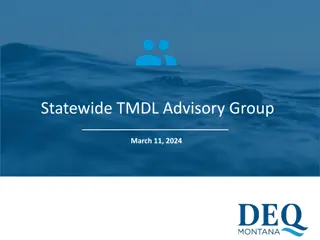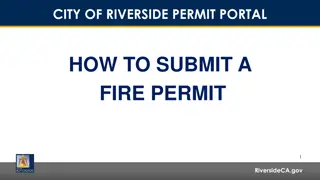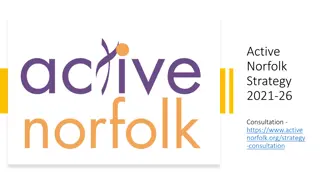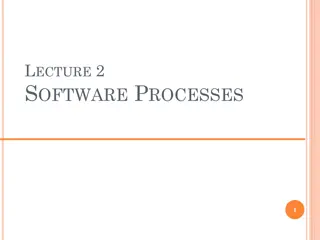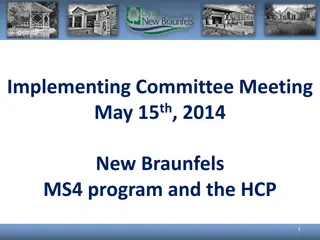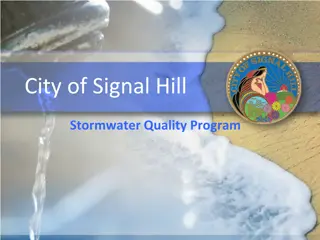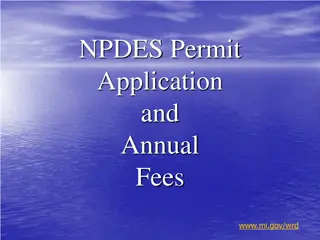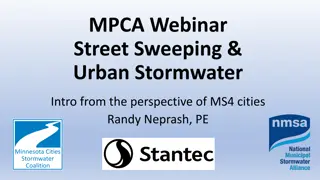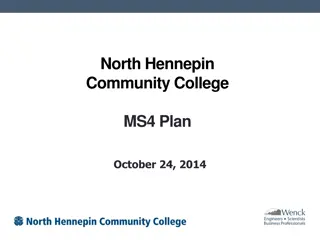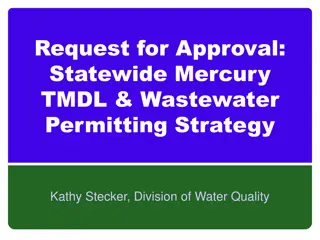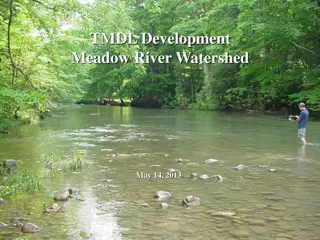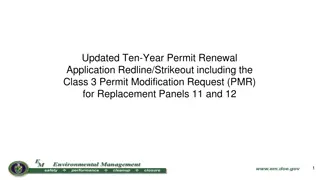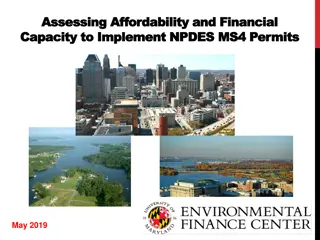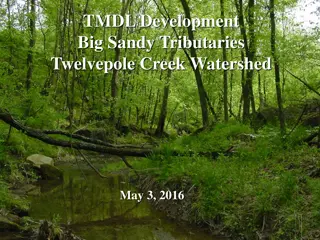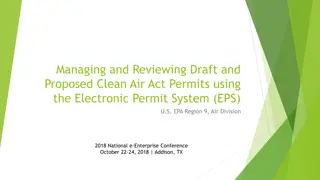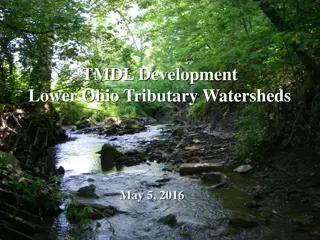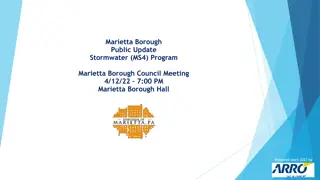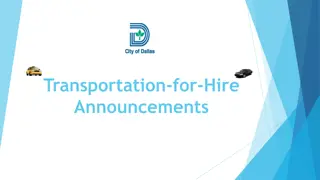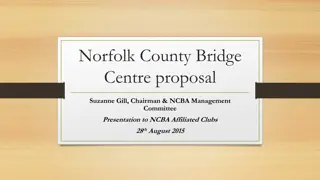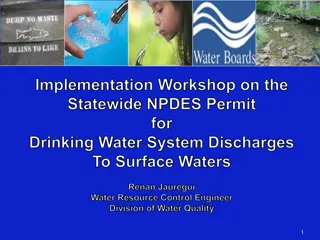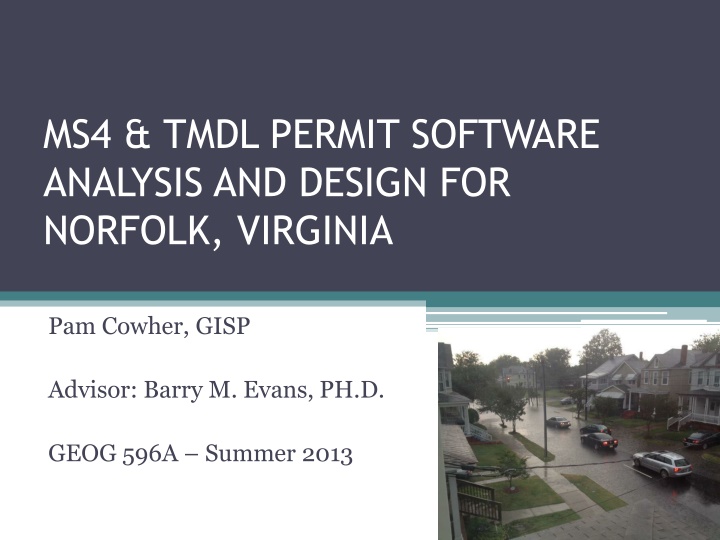
MS4 & TMDL Permit Software Analysis and Design for Norfolk, Virginia
Explore the need for MS4 software for managing stormwater in Norfolk, Virginia. Learn about MS4 types, Chesapeake Bay TMDL, progress tracking, and existing COTS MS4 software options available. Discover the importance of MS4 management software in meeting regulatory requirements and ensuring environmental compliance.
Download Presentation

Please find below an Image/Link to download the presentation.
The content on the website is provided AS IS for your information and personal use only. It may not be sold, licensed, or shared on other websites without obtaining consent from the author. If you encounter any issues during the download, it is possible that the publisher has removed the file from their server.
You are allowed to download the files provided on this website for personal or commercial use, subject to the condition that they are used lawfully. All files are the property of their respective owners.
The content on the website is provided AS IS for your information and personal use only. It may not be sold, licensed, or shared on other websites without obtaining consent from the author.
E N D
Presentation Transcript
MS4 & TMDL PERMIT SOFTWARE ANALYSIS AND DESIGN FOR NORFOLK, VIRGINIA Pam Cowher, GISP Advisor: Barry M. Evans, PH.D. GEOG 596A Summer 2013
Agenda Background Why is an MS4 Software Needed Project Goals Methodology Timeline Expected Outcomes
Introduction What is an MS4? Municipal Separate Storm Sewer System (MS4) Water conveyance system: 1. Owned by public entity 2. Collects and discharges stormwater 3. Not a combined sewer 4. Not part of sewage treatment system Limit pollution from suburban / urban stormwater
Introduction (cont.) MS4 Types Phase 1 (Large MS4) Urban area Population greater than 100,000 Approximately 100 in nation (11 in Virginia) Permits are customized to each jurisdiction Phase 2 (Small MS4) Urban area as defined by U.S. Census Less than 100,000 residents General permit for all
Introduction (cont.) Chesapeake Bay TMDL Established in 2010 to clean- up the Bay Largest TMDL Pollution Diet Sets allocation goals for VA that must be met by 2025 Nitrogen Phosphorus Sediment
Bay TMDL Progress Reporting Progress towards TMDL Goals tracked by BMP implementation Urban Agricultural How? Number of BMPs Drainage Area to BMP combined with land use to determine loading Why? If MS4 cannot show progress towards goals may have financial consequences
Why do MS4s need management software? New permits issued in Virginia Require large amount of data tracking and reporting TMDL requirements for Chesapeake Bay Watershed MS4s required to inspect facilities and BMPs that discharge into their system Annual reporting requirements
Existing COTS MS4 Software Many available MS4 specific MS4 Permit Manager / MS4 Web PermiTrackMS4 Operation MS4 Full City Asset Management Software Azteca Cityworks Stormwater Module Cartegraph Accela
Why are commercial software not being used? Asked 2 local cities this question. Similar responses: Not customizable enough for individual needs Inputs are required from too many departments Duplicated entry into many systems High cost of implementation
Study Area Norfolk, VA Phase I MS4 Approx. 33,000 ac MS4 Area = 23,000 ac (70% of land area) 42% of land area is impervious Drains directly to Bay
Project Goals Design a relational database to store data related to Bay TMDL and MS4 Permit Design front-end system for data entry and attribute reporting and querying Front-end system must: Have an interactive map Be web based Be customizable
Methodology Conduct user group interviews Norfolk Storm Water managers Field inspectors Customer service agents GIS Staff
Methodology (cont.) Design Database Schema Over 25 sections in MS4 permit that must be tracked Data are both spatial and non-spatial Tables will include: Land Cover (spatial) BMPs (spatial) E & S Inspection (non-spatial) BMP Inspections (non-spatial) Nutrient management areas (spatial/non-spatial) Dry and Wet weather monitoring data (spatial/non) And many others .
Methodology (cont.) Data schema result will be UML diagram or similar documenting tables and relationships.
Methodology (cont.) Prototype application Design web forms Input Reports Forms will not be linked to back-end data at this point City of Norfolk staff will review and comment
Methodology (cont.) Create "Tie-ins" from the Prototype application to the database Database to GIS Services Database to Web applications Link data to forms and reports Start to create ArcGIS for Flex Application Finalize Application with input from Norfolk staff
Methodology (cont.) Design System Architecture Web Application Server Web forms, editing, report creation. MS4 & TMDL Permitting App Desktop Internet SQL Server Express Database GIS Server (ArcGIS for Server) MS4 & TMDL Permitting App Mobile Application Mapping Services Geoprocessing Other data hosting
Timeline Prior to August 14: Conduct user interviews August 14 - 21: Develop data schema that will be the basis of the project August 22 - 31: Provide schema to City of Norfolk staff to review September 1 - 8: Develop sketch of application design (non-working prototype) September 9 - 15: Create tie-ins between data and application September 17: Present prototype at the Virginia GIS conference (Williamsburg, VA) September 18 - October 4: Continue development (working prototype) October 4 - October 11: Working prototype to City of Norfolk staff for review and comments October 12 - 23: Finalize application to acceptable research grade quality, write final report, and provide research grade application to the City of Norfolk.
Expected Outcomes Working web application to: Manage the MS4 / TMDL portion of Stormwater program Allow multiple tabular edits Allow map inputs and spatial edits Report on progress towards TMDL goals Report on MS4 Annual Report requirements Application will be considered research grade and not production ready
Acknowledgements Barry M. Evans, PH.D. City of Norfolk Storm Water Department Penn State University MGIS Program
References Accela, Inc. (2013). Accela, Inc. Better Government through Civic Engagement. Retrieved 6 28, 2013, from Accela, Inc.: http://www.accela.com/ ASSIST. (2006). ASSIST - Comprehensive Asset Management. Retrieved 6 28, 2013, from ASSIST: http://www.asist.net/ Azteca Systems, Inc. (2012). Home. Retrieved 6 28, 2013, from Cityworks: http://www.cityworks.com/ Butler, Fairman, and Seufert. (2013). Home. Retrieved 6 28, 2016, from Operation MS4: http://www.operationms4.com/ Cartegraph. (2013). Cartegraph. Retrieved 6 28, 2013, from The Operations Management System: http://www.cartegraph.com/ CBI Systems. (2013). Home. Retrieved 6 28, 2013, from MS4 Web MS4 Permit Manager: http://www.ms4web.com/ Committee on the Evaluation of Chesapeake Bay Program Implementation for Nutrient Reduction to Improve Water Quality. (2010). Achieving Nutrient and Sediment Reduction Goals in the Chesapeake Bay: An Evaluation of Program Strategies and Implementation. Washington, D.C.: The National Academies Press. Houston Engineering, Inc. (2012). MS4Front.com. Retrieved 6 28, 2013, from MS4Front: http://www.ms4front.com/ SEH Technology Solutions. (2013). PermiTrack. Retrieved 6 28, 2013, from PermiTrack: https://www.mypermitrack.com/sehsvc/
Questions? Contact: Pam Cowher, GISP pjc256@psu.edu

